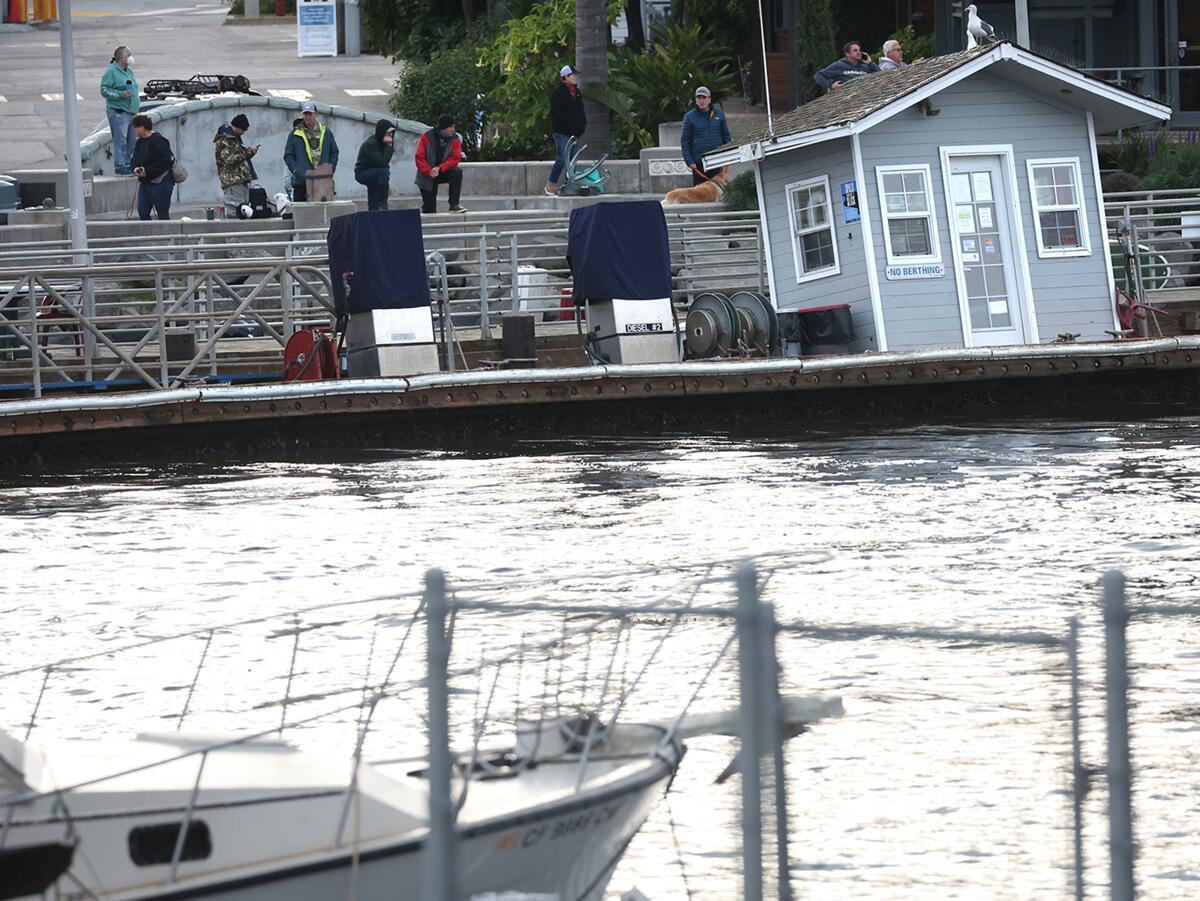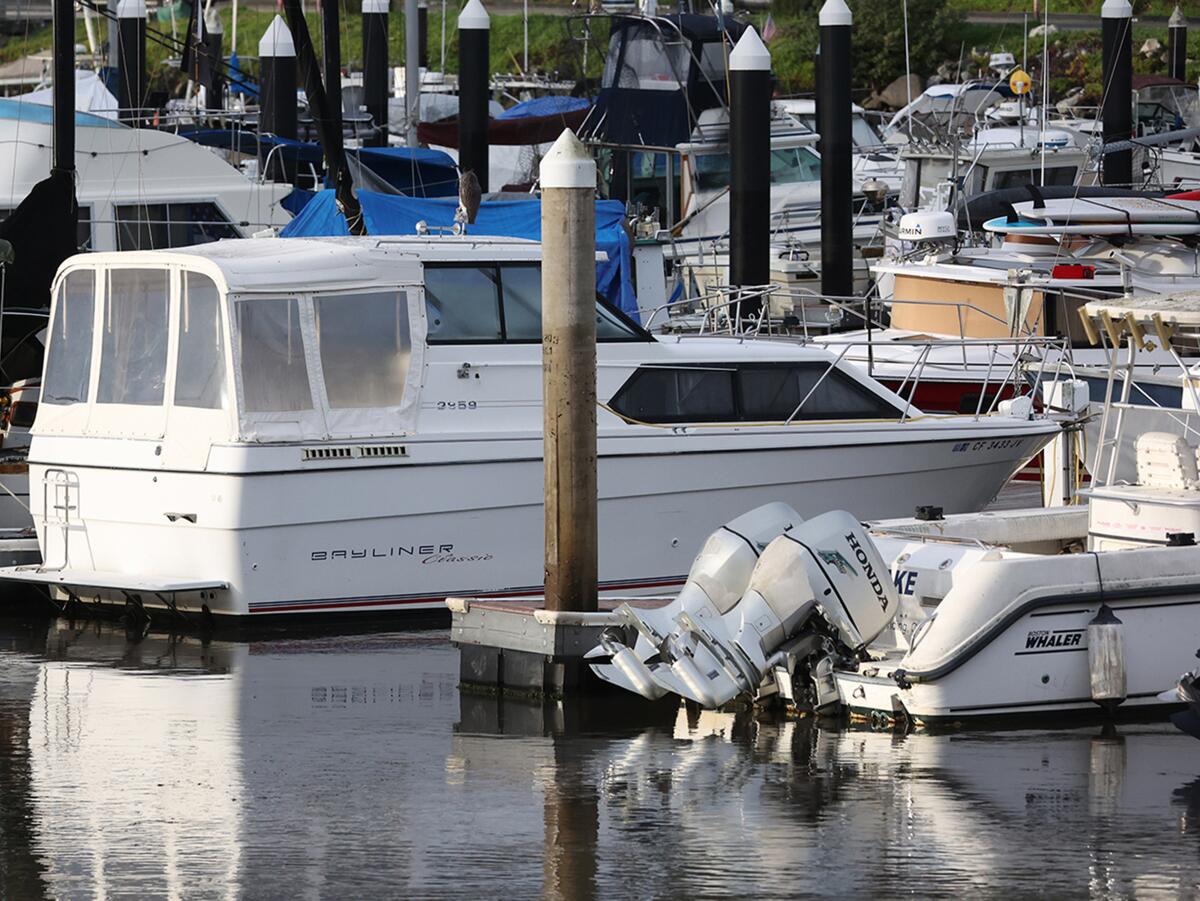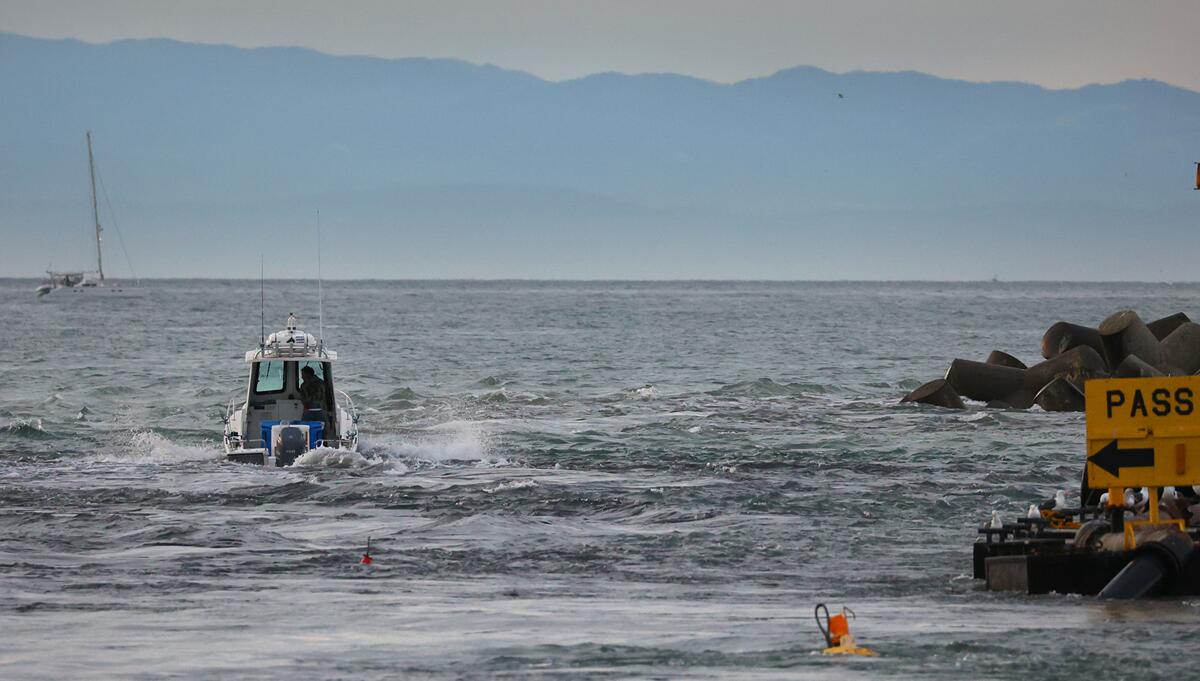The tsunami that battered Santa Cruz highlights the threat facing California’s coast

- Share via
When harbor officials warned Kenneth Stagnaro of a tsunami heading from Tonga for the Santa Cruz Harbor last weekend, he decided to take his two boats out to sea.
Out there, Stagnaro, who runs a whale watching and charter fishing business, felt he could ride out the worst of the tsunami.
It’s what he and dozens of other large boat owners did in 2011 when a violent tsunami from a magnitude-9 earthquake in Japan capsized boats in the harbor and shredded whole docks, pulling them into the ocean, causing about $20 million in damage, and a total of $100 million in damage to harbors along California’s coast.
In the end, last Saturday’s tsunami that hit the California coast was smaller and less damaging. But it still caused an estimated $6 million in damage to Santa Cruz alone — and was a reminder of the importance of preparing for tsunamis along the coast.
Some experts said the latest event showed that major upgrades that harbors like Santa Cruz underwent in the decade since Japan have made a difference.
“That’s a great indication that their rebuild they did after 2011 did its job,” said Patrick Lynett, a coastal engineer at USC who for the past decade has been helping cities across California bolster their infrastructure for tsunamis.
Among those cities is Crescent City, which Lynett calls “a magnet for tsunamis” due to its position near a major subduction zone beneath the surface of the Pacific Ocean that causes major earthquakes and can cause massive tsunamis.
Since 2011, when the tsunami from Japan killed one person and destroyed much of Crescent City’s harbor, inflicting $50 million in damage, the city rebuilt it into what it declared in 2014 as the world’s first “tsunami-resistant harbor.” Pilings are larger, doubling its previous size, and are planted deep within the bedrock of the seafloor. Docks were designed to withstand the force of tsunamis even more powerful than ones seen in 2011.
Officials are still tallying the damage from Saturday. Though statewide damage estimates have yet to be released, the California Governor’s Office of Emergency Services expects damage costs to be significantly lower than in 2011.
The tsunami coupled with high tides, caused flooding unseen before in some parts of Santa Cruz. The waters poured into into bathrooms and electrical transformers on shore, and into parking lots where cars floated about like toy boats.

Heavy currents pulsed throughout the harbor, tearing away at docks, twisting steel piping of the harbor’s dredge like licorice, and floodwater flushed in and out the harbor at high speeds, transforming it into what Stagnaro described as whitewater rapids.
Experts like Lynett were still surprised at how the tsunami was generated and how long the event lasted.
Most tsunamis that strike California’s coast — 150 since 1880 — come from earthquakes, as in 2011.
It’s rare for a volcanic eruption to be the culprit, Lynett said. Experts were initially caught off-guard by the tsunami’s size and power across the Pacific Ocean.
The large waves seen in Tonga were probably from an underwater landslide after the volcano erupted. The waves generated beyond Tonga, however, may have come from the sonic boom of the blast itself, which Lynett said is a new phenomenon.
“We have not seen something like this, pretty much in the field of the study,” Lynett said.
This possibly explains why a tsunami advisory, which usually comes far earlier than arrival, was sent out to California officials just several hours before the event, he said.
Lynett was also surprised at just how sustained the tsunami was behaving, lasting more than 24 hours into Sunday afternoon. The 2011 tsunami ended mostly within a day’s time.
John Higgins, the harbormaster in Ventura, was among those frustrated by the incessant currents, trying to keep the harbor in order, while still fielding normal calls for service.
The first major surges came around 11 in the morning, capsizing one of his patrol boats. The evening brought no respite: About 6 p.m., Higgins received a call of a 70-foot yacht and a 90-foot slab of the adjoining concrete dock had broken off and floated down the harbor and toward the ocean.
Harbor towboats grabbed hold of the yacht and a smaller boat that had been caught in the 70-footer’s movement.
The next day, amid a still-tempestuous current, a boat outside the harbor had reported a 10-foot chunk of the runaway concrete dock floating out at sea.
“It was overwhelming,” said Higgins, who runs a staff of eight people.
Ventura was another city that was hit hard by the 2011 tsunami. Though the damage was worse then, more than two dozen docks were marred by currents, Higgins said. The county had not yet finished a damage estimate. A replacement for the capsized boat is expected to cost about $500,000 to $1 million, Higgins said.
Other places that saw minor damage to their ports over the weekend included Moss Landing in Monterey County, Port San Luis in San Luis Obispo County and Arena Cove in Mendocino County.
Throughout the past week, field teams with the state and federal government dispersed along the coastline to chart just how high the waters rose on Saturday and Sunday.
In Santa Cruz, some teams arrived to find Sharpie markings along some buildings that some in the harbor scrawled to show the floodwater height, said Nick Graehl of the California Geological Survey.
He and Bruce Jaffe of the U.S. Geological Survey spent much of Thursday walking along Santa Cruz’s coastline, analyzing a long line of wood, trash and dead sea animals, such as a large crab that caught Jaffe’s eye, left behind high on the shore by the tsunami’s currents.
Jaffe worries that with sea level rise brought through climate change, tsunamis have potential to be worse, rising higher onto the shore and causing more damage.

“With sea level rise, the effects of tsunamis are gonna become larger, just because the wave is now riding on a higher water level,” he said.
Holland MacLaurie, port director of the Santa Cruz Harbor, said she saw flooding in parts of the harbor that had never flooded in its 58-year history. Much of this was attributed to the timing of the high tide, coinciding with the tsunami. Sea level rise would exacerbate such an incident.
“I can only imagine in the future it’s going to get worse, or will be more impacted by sea level rise,” MacLaurie said.
She hopes the harbor can better prepare with things such as elevating electronic transformers, building some infrastructure higher on shore, beefing up pilings that hold docks in place, and upgrading some docks.
But even with the improvements, some things, like the dredging system, will always exist “at the mercy of when the next tsunami occurs,” MacLaurie said.
It’s an accepted reality of living and doing business along the Pacific Coast for some lifelong residents like Stagnaro, 60, who took over his family’s business several decades ago.
“You can’t pick your harbor,” he said. “And you can’t really just pick up and go somewhere else.”
Just before sunset on Saturday, Stagnaro and his co-captain steered their two ships into the harbor. They squeezed through a narrow gap between the unhinged cables of the damaged dredge and the jetty, a pile of boulders.
With the current still swirling, they timed their movement between the surges and the rising and falling sea levels, sitting idle as the water raged, then, when there was a calm, gunning it toward his dock.
Stagnaro arrived back on shore to find his Toyota Tacoma wrapped in floodwater. Nearby docks were damaged. Some metal pilings were bent. The power was out, forcing him to dump meat from his freezer. He canceled all appointments Sunday as the tsunami raged in the harbor.
The scene was tamer than in 2011, when Stagnaro camped overnight on his boat, armed with a long metal pole to push chunks of sunken boats and damaged docks from striking his boat.
By Monday, the waters receded, power was restored, and Stagnaro was able to take his boats out again, this time for business.
More to Read
Sign up for Essential California
The most important California stories and recommendations in your inbox every morning.
You may occasionally receive promotional content from the Los Angeles Times.










